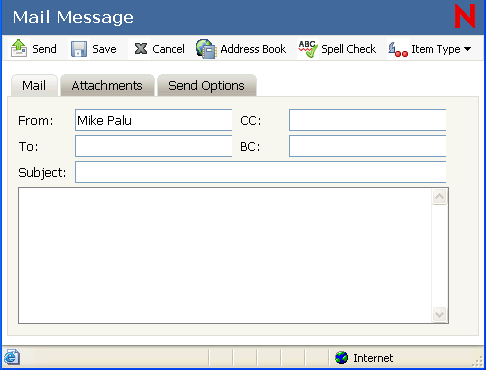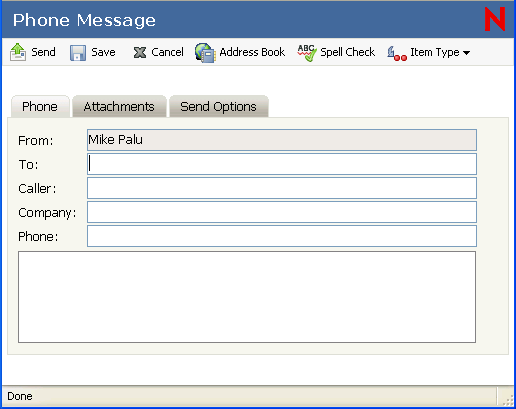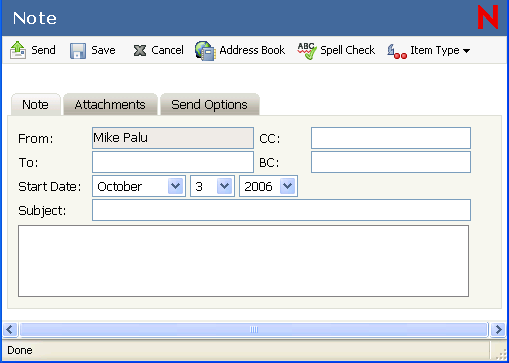2.1 Composing Items
GroupWise WebAccess has five different item types: mail message, phone message, appointment, note, and task. You address all item types in the same way, using the Address Book to add recipients’ addresses to the To, CC, and BC boxes. You can also attach files to each item type and include Web site locations (URLs) in the Subject and Message box of each item type.
These five item types fit into three categories: unscheduled, scheduled, and posted items.
-
Unscheduled Items: Unscheduled items include mail messages and phone messages. Both types of messages let you send a messages that are not scheduled for a particular time or date.
-
Mail Message: Lets you specify a subject and message.
-
Phone Message: Similar to mail messages, except that phone messages have boxes for caller, company, and phone number information.
-
-
Scheduled Items: Appointments, tasks, and notes are scheduled items, meaning that they appear in the recipient’s Calendar as well as the Mailbox. The recipient of an appointment, task, or note has the option of accepting or declining it. Accepted items are removed from the recipient’s Mailbox and stored in the recipient’s Calendar. Declined items are removed from both the recipient’s Mailbox and the Calendar. If you are the sender, you can see what action recipients have taken by checking the status information for the scheduled item.
-
Appointment: Lets you include the time, date, and place of the appointment. You can use Busy Search to find times when all recipients are free.
-
Task: Lets you indicate which day you want the task to appear in the recipient’s Calendar and which day you want the task completed. You can also assign a priority to the task.
-
Note: Lets you indicate which day you want the note to appear on the recipient’s Calendar. Because notes are posted in the recipient’s Calendar, they are frequently used as reminders of specific events, such as days off, project deadlines, or birthdays.
-
-
Posted Items: Posted items are scheduled items you create for yourself. They function like other scheduled items, but are placed directly in your Calendar.
For all items, GroupWise WebAccess uses the default font setting that is set in your browser. To change the font size of your incoming and outgoing messages, change the size in your browser preferences. For more information, see your browser’s help files.
This section contains the following topics:
2.1.1 Sending a Mail Message
-
In the GroupWise WebAccess main window, click > .

-
Click Address Book to add recipients in the , , and fields.
or
Type a recipient’s address in the , , or fields. The address can be a GroupWise user ID, GroupWise full name, or external e-mail address. Separate each address with a comma.
When you begin typing a name in the , , or fields of an item you are creating, Name Completion tries to complete the name for you. If Name Completion finds the name you are looking for, you can stop typing. If Name Completion doesn’t find it, continue typing: Name Completion searches again after each new character you type. If Name Completion finds a name that is close to but doesn’t exactly match the one you are looking for, you can use the Up- or Down-arrow to scroll to adjacent names in the address book.
IMPORTANT:Name-completed addresses for all item types come only from the Frequent Contacts address book.
-
Type a subject and message.
You can include Web site locations or addresses (URLs) in both the Subject and Message boxes.
-
(Optional) Click to check the spelling in the message. For this feature to work, your browser must be enabled for Java*.
-
(Optional) Click to attach files to the message. For this feature to work, your browser must support attachments.
-
(Optional) Click to select a security setting (classification), assign a priority (high, standard, low), request a reply, or select to receive return notification.
-
Click .
If a Web server outage occurs while you are composing a message, your message is not lost when you click . It is captured and appears at the bottom of the WebAccess Login page so that you can retrieve it when your Web server comes back up and you log into WebAccess again.
2.1.2 Sending a Phone Message
GroupWise phone messages are similar to paper-based While You Were Out messages. You send GroupWise phone messages to inform other users of calls and their details. GroupWise phone messages do not send spoken messages.
-
In the GroupWise WebAccess main window, click .

-
Click to add recipients in the field.
or
Type a recipient’s address in the field. The address can be a GroupWise user ID, GroupWise full name, or external e-mail address. Separate each address with a comma.
IMPORTANT:Name-completed addresses for all item types come only from the address book.
-
Type the caller, company, and phone information.
-
Type a message.
You can include Web site locations or addresses (URLs) in the field.
-
(Optional) Click to spell check the message. For this feature to work, your browser must be enabled for Java.
-
(Optional) Click to attach files to the message. For this feature to work, your browser must support attachments.
-
(Optional) Click to select a security setting (classification), assign a priority (high, standard, low), request a reply, or select to receive return notification.
-
Click .
2.1.3 Writing a Note
-
In the GroupWise WebAccess main window, click

-
Click to add recipients in the , , and fields.
or
Type a recipient’s address in the , , or field. The address can be a GroupWise user ID, GroupWise full name, or external e-mail address. Separate each address with a comma.
To create a personal note that displays only in your Calendar, add only your name or switch to a posted note.
-
Specify the month, day, and year you want the note to appear on the recipient’s Calendar.
-
Type a subject and message.
You can include Web site locations or addresses (URLs) in both the and fields.
-
(Optional) Click to spell check the message. For this feature to work, your browser must be enabled for Java.
-
(Optional) Click to attach files to the note. For this feature to work, your browser must support attachments.
-
(Optional) Click to select a security setting (classification), assign a priority (high, standard, low), request a reply, or select to receive return notification.
-
Click .
For information on creating an appointment, see Section 4.1, Scheduling Appointments. For information on creating a task, see Section 4.2, Sending Tasks.
2.1.4 Sending or Receiving an Internet Location
WebAccess allows you to send a Web site location, or URL, to another user. WebAccess formats any URL in the Message box into a shortcut to the Web site. The recipient who opens your message in WebAccess can click the shortcut to open a second browser window that displays the Web site.